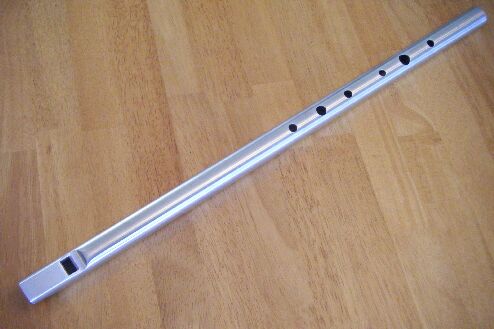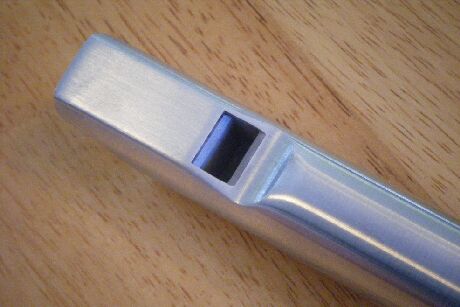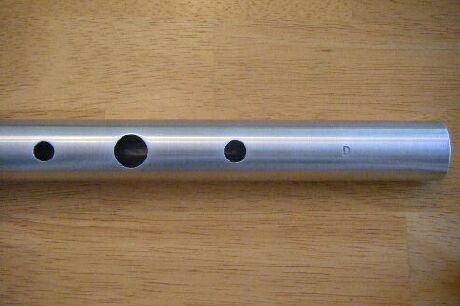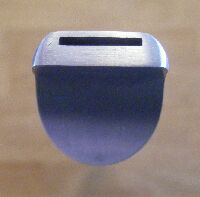Maker - Kerrywhistles (Phil Hardy) www.kerrywhistles.com
Material - Aluminum
Dimensions: Length - 22 7/8ths"
Distance between 1st and 3rd bottom holes - 3"
Diameter of 2nd hole from bottom - 1/2"
Bore - 7/8ths"
Weight - 7oz
Price at time of review - 120 lbs direct from Maker
This
whistle was very generously given to me by Phil Hardy of Kerrywhistles
so that I could have a complete set of reviews of the whole Chieftain
line; OS (Old Style), Gold (Brass), NR (New Range), and V3 (Version
three). Last time I heard, the V3's were available from
distributors while the NR was now only going to be available
direct from Kerrywhistles. The OS and Gold are discontinued.
On a side note, a very informative and interesting video history of the Chieftain whistle can be viewed here on the Kerrywhistles website. It is entitled "Know your Chieftain" and is narrated by Phil Hardy himself.




On a side note, a very informative and interesting video history of the Chieftain whistle can be viewed here on the Kerrywhistles website. It is entitled "Know your Chieftain" and is narrated by Phil Hardy himself.




Appearance: OK,
I won't say it!... um, Maybe I should try something like "a
shaft of exquisitely smooth cylindricalness with pleasing spherical
voids". Nah, tube, holes, you get the picture. From a
distance, the NR doesn't look that much different from the OS, but
closer inspection reveals several key differences. The wind way on the
NR is considerably shorter width wise than on the OS, but is also
slightly larger in height. The length of the fipple/mouth piece is also
a bit longer, and the corners have been rounded off by hand making it
more comfortable on the lips. The window on the NR is also larger,
increasing the distance from the wind way to the blade and the angle of
the window when viewed in profile is also steeper. All this adds up to
a fairly large redesign of the head from the OS, although not quite as
extreme as with the V3. One last nice new touch is that the bottom edge
of the whistle has been nicely rounded, to give a more neat,
professional appearance. A feature of the Chieftain NR and OS
that I really like is that the second hole from the bottom is more
centrally located between the first and the third holes. This is
different than most low whistles where the second hole tends to be
closer to the third, making a large gap between the first and the
second. I find this to be more comfortable on the right hand, though it
does make for a larger second hole. (This has slightly changed on the
V3)
Tone: The tone of the NR is slightly brighter than that of the OS, but is allot more breathy, although not quite as breathy as the V3.
Volume: The NR is also slightly louder than the OS, especially on the bottom end, likely due to the increased backpressure. I would put it in the medium/moderate range, possibly good for smaller sessions.
Backpressure/air requirement:The NR has noticeably more backpressure than the OS, putting it in the moderate to high range. This gives it a lower air requirement and a stronger bottom end, causing the low fundamental not to break as easily.
Responsiveness: The NR is a hair more responsive than the OS, though no where near as responsive as the V3. Ornaments are clear but not overly crisp. The NR is allot better suited to playing reels and jigs than the OS, which is better suited to airs.
Clogging: I did not experience any clogging issues with this whistle once it was warmed up, but like most aluminum whistles, it will clog if blown when it's cold.
Tuning: This whistle has some of the same tuning issues that the other Chieftains do. In the second octave, all the notes from the G on up were around 10-15 cents flat. These of course can be pushed with breath support and/or velocity to somewhat compensate, but this can effect the tone and certainly the volume. C natural was good using the standard OXXOOO fingering.
Sound clip: Da Slockit Light
Summary: While the increased backpressure and responsiveness make the NR easier to play, I still prefer the sound of my OS. But, even though the tone is breathier than I personally prefer, it is still very much a good sounding whistle. Chieftains are often maligned for being factory made, verses hand made. But as Mr Hardy has stated, the purpose of factory making whistles was to produce a good quality instrument for less money and in less time, so that one would not have to languish on a waiting list. With that in mind, I think Phil and Kerrywhistles have succeeded admirably. The quality of the Chieftain line continues to improve, and has come along way. I look forward to the V4. Four holes.

Tone: The tone of the NR is slightly brighter than that of the OS, but is allot more breathy, although not quite as breathy as the V3.
Volume: The NR is also slightly louder than the OS, especially on the bottom end, likely due to the increased backpressure. I would put it in the medium/moderate range, possibly good for smaller sessions.
Backpressure/air requirement:The NR has noticeably more backpressure than the OS, putting it in the moderate to high range. This gives it a lower air requirement and a stronger bottom end, causing the low fundamental not to break as easily.
Responsiveness: The NR is a hair more responsive than the OS, though no where near as responsive as the V3. Ornaments are clear but not overly crisp. The NR is allot better suited to playing reels and jigs than the OS, which is better suited to airs.
Clogging: I did not experience any clogging issues with this whistle once it was warmed up, but like most aluminum whistles, it will clog if blown when it's cold.
Tuning: This whistle has some of the same tuning issues that the other Chieftains do. In the second octave, all the notes from the G on up were around 10-15 cents flat. These of course can be pushed with breath support and/or velocity to somewhat compensate, but this can effect the tone and certainly the volume. C natural was good using the standard OXXOOO fingering.
Sound clip: Da Slockit Light
Summary: While the increased backpressure and responsiveness make the NR easier to play, I still prefer the sound of my OS. But, even though the tone is breathier than I personally prefer, it is still very much a good sounding whistle. Chieftains are often maligned for being factory made, verses hand made. But as Mr Hardy has stated, the purpose of factory making whistles was to produce a good quality instrument for less money and in less time, so that one would not have to languish on a waiting list. With that in mind, I think Phil and Kerrywhistles have succeeded admirably. The quality of the Chieftain line continues to improve, and has come along way. I look forward to the V4. Four holes.